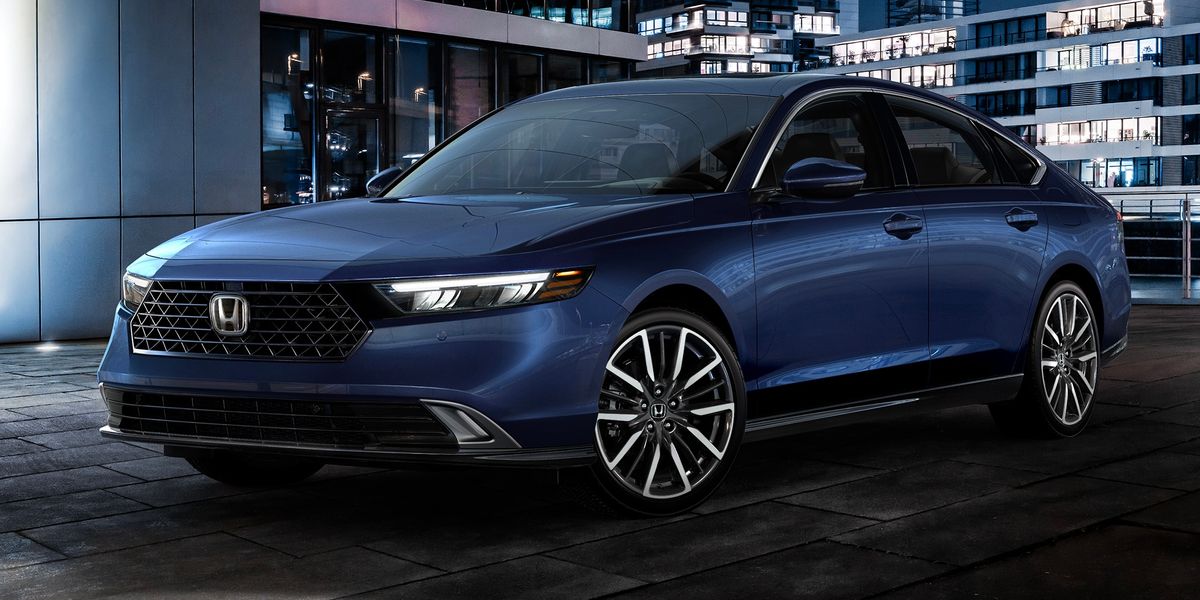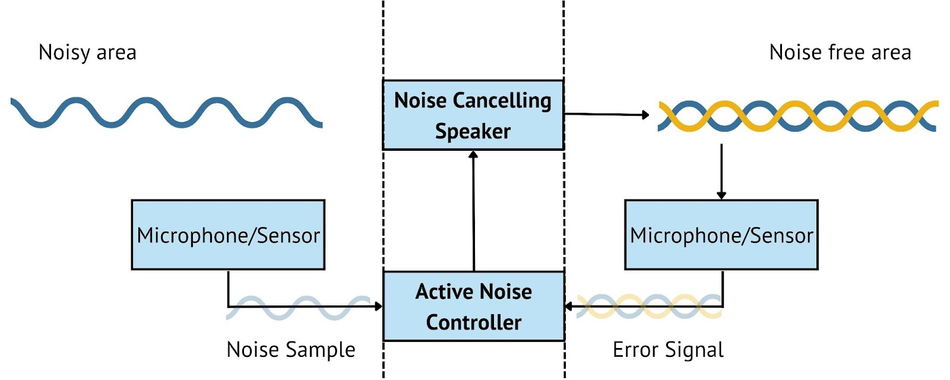Active Noise Cancellation in Electric and Autonomous Vehicles

Honda Accord (2023) with Active Sound Control
Article #7 of Innovations in Electric and Autonomous Vehicles Series: As electric vehicles (EVs) gain traction, challenges surrounding noise cancellation are dramatically changing, and the desire to reduce the weight of EVs is driving engineers toward active noise-cancellation solutions.
This article was discussed in our Next Byte podcast.
The full article will continue below.
This is the seventh article in an 8-part series featuring articles on Innovations in Electric and Autonomous Vehicles. The series presents an insight into the developments and challenges in the automotive sector as it undergoes massive transformations with the arrival of electric and self-driving vehicles. This series is sponsored by Mouser Electronics. Through the sponsorship, Mouser Electronics shares its passion for technologies that enable smarter and connected applications.
With all-electric vehicles (EVs) poised to take over the automotive industry, noise cancellation within the vehicles themselves has taken a left turn. Rather than eliminating noise from the internal combustion engine, noise-canceling systems are now being required to reduce road and mechanical noise, using a variety of methods in addition to traditional audio anti-noise techniques.
This article examines the algorithms applied in the newest noise-canceling systems designed for EVs, including new uses of sensors. It also introduces readers to the necessity of noise cancellation, the sources of noise in an EV, the working of noise cancellation technologies, and the challenges faced by system designers for implementing them in automobiles.
Why Is Noise Reduction in Vehicles Important?
If one fact about driving rarely gets attention, it’s that modern cars are very quiet inside. But making a car quiet is no easy task. Automotive engineers leverage two main approaches for reducing noise: passive and active.
Passive noise reduction uses the natural properties of materials to remove noise that reaches the internal cabin. Such reduction can be achieved with the use of foam, suspension, and insulation, which all try to put as many boundaries as possible between passengers and the noise source.
Active noise cancellation (ANC) instead seeks to create sound waves that are equal but opposite to the noise source. When two waves of equal magnitude but opposite polarization interact, they cancel each other out (i.e., destructive interference). This technique is becoming increasingly popular.
But why is the removal of noise important in modern vehicles?
Removing noise is essential in improving driver awareness, creating a relaxed atmosphere, and ensuring the health and safety of vehicle usage. Just about all noise sources can potentially interfere with the thought process of a driver, and a distracted driver is an unsafe driver; thus, those who operate near machinery are almost always expected to wear ear protection.
Moreover, by considering ANC in the design stage, carmakers can reduce the tradeoffs typically needed in the car design process, enabling engineers to minimize compromises and maximize performance.
Where Does Noise Come from in Cars?
The first step in effectively removing noise is identifying where the noise comes from. In modern gas vehicles, noise comes from the engine, the wheels rubbing against the road, and the air rushing past the vehicle. These sources of noise are almost identical for EVs, with the exception that instead of receiving noise from an engine, other noise sources—such as the heating, ventilation, and air conditioning (HVAC) system, battery, and pedestrian warning system (i.e., fan motor noise)—became dominant and more noticeable.
Suggested reading: Improving HVACR and IAQ control systems with innovative IIoT sensors
A common myth exists that EVs are quieter than gas vehicles. While EVs are quieter when operating at very low speeds (less than 10 kmph), at higher speeds, wind shear on the car and contact between the wheels and the road create dominant sources of noise. The automotive industry is aware that wind noise has increased significantly, and noise from the powertrain and ancillaries is more prominent.
How Does Active Noise Cancellation Work in Modern Electric Vehicles?
In the context of removing noise in a vehicle through active methods, creating an ANC environment inside the entirety of a vehicle's cabin is virtually impossible. Like modern headphones, ANC in vehicles specifically targets passengers, essentially creating noise-free bubbles around the passengers’ heads.
Furthermore, frequencies above 1 kHz are not reduced, as most intrusive noise (i.e., noise from the wind and road) exists in frequencies of less than 1 kHz. Sudden noise—from sources such as pedestrians, other vehicles, and emergency sirens—is also not reduced above this level.

ANC systems consist of vibration sensors in the vehicle’s suspension, microphones in the cabin, and speakers placed around the headrest of each seat. A high-end processor computes the data to create the correct waveforms from each seat, but such processing requires digital signal processing capabilities.
For ANC, vibrations in the suspension are picked up by sensors and sent to a digital signal processor. Customized algorithms and filters then determine when and how to create opposing sound waves in the passengers’ headrests. Internal cabin microphones check if the cancellation algorithms are operating correctly and provide feedback for the processor to adjust opposing sound waves.
Why Is Active Noise Cancellation Advantageous in Modern Electric Vehicles?
While noise reduction improves driver awareness and the health and safety of vehicle usage, active noise cancellation provides other benefits that are especially useful for modern and future EVs.
The first advantage, one of the most important by far, is that active noise cancellation removes the need for passive noise cancellation. Removing large amounts of foam and padding allows for EVs to be lighter, in turn increasing their driving range. This increased range reduces the overall CO2 generated during vehicle charging (EVs are charged via the grid, which still is powered by fossil fuels).
The second advantage is that ANC can create an office-like environment for passengers. Autonomous vehicles of the future may allow passengers to forfeit all control of the vehicle. Instead of concentrating on the road, passengers could be productive on their commute, accomplishing office-related tasks. This technology could also be implemented in public transport—whether via rail, air, or coach—to provide passengers with a more comfortable experience.
What Challenges Does the Active Noise Cancellation Face?
If ANC was as simple as detecting vibrations in the suspension and creating opposing sound waves, then all cars would be fitted with such systems already. However, achieving ANC is extremely complicated due to many factors.
One factor is the extremely high speed of sound in physical materials. For example, the speed of sound in steel is at least 3 km/s. Only milliseconds exist between a sound entering the suspension and transmitting to passengers. As such, the microphone, processor, and speaker have limited time to detect the sound, create an opposing sound wave, and emit it to passengers; this quick turnaround limits the maximum frequencies that can be handled. To solve this challenge, the distance between the vibration sensors and the passengers needs to be maximized, and unique noise canceling algorithms for each vehicle type and internal environmental conditions should be applied.
A second factor is that the acoustic environment of a cabin highly depends on the presence of objects and people, the vehicle’s speed, and the road surface texture, so no single algorithm solves every possible scenario. Therefore, modern ANC systems must be able to access key vehicle data, such as which seats are occupied, the current speed of the vehicle, and whether any windows and doors are open.
Conclusion
ANC is an extremely powerful technique for removing noise in modern vehicles, and its benefits in EVs extend beyond the passenger experience. The reduction in weight enabled by eliminating the need for passive noise-removal techniques can help increase the range of EVs, while the ability to selectively remove frequencies allows passengers to have a greater awareness of their environment.
But developing ANC techniques is no small feat, with major challenges introduced by the need for digital signal processors coordinating with in-car sensors. Over the next couple of years, as the ANC systems mature, we’ll see the technology getting incorporated into more EVs and autonomous vehicles to improve efficiency, reliability, and the overall user experience.
This article is based on an e-book by Mouser Electronics. It has been substantially edited by the Wevolver team and Electrical Engineer Ravi Y Rao. It's the seventh article from the Innovations in Electric and Autonomous Vehicles Series. Future articles will introduce readers to some more trends and technologies transforming the automotive sector.
The introductory article presented the different topics covered in the Innovations in Electric and Autonomous Vehicles Series.
The first article discussed the present state of autonomous vehicles.
The second article explains MaaS and how improvements in automotive technologies are speeding up its adoption.
The third article takes a look at how the 3GPP intends to use 5G in V2X applications with significant advantages over current dedicated short-range communication or other Cellular-V2X proposals.
The fourth article explains Driver Monitoring Systems (DMS) and their role in reducing the possibility of mishaps due to human errors
The fifth article examines some of the ways EV technologies will evolve, and some of the obstacles they need to overcome before the automotive industry can transition to fully electric
The sixth article discusses solid-state batteries, a promising alternative to conventional Li-ion batteries
The seventh article explains active noise cancellation and why it’s a very effective solution for eliminating noises in automobiles
The final article focuses on Human Machine Interfaces, the sleek and stylish dashboards that are changing the way we interact with cars
About the sponsor: Mouser Electronics
Mouser Electronics is a worldwide leading authorized distributor of semiconductors and electronic components for over 1,200 manufacturer brands. They specialize in the rapid introduction of new products and technologies for design engineers and buyers. Their extensive product offering includes semiconductors, interconnects, passives, and electromechanical components.

